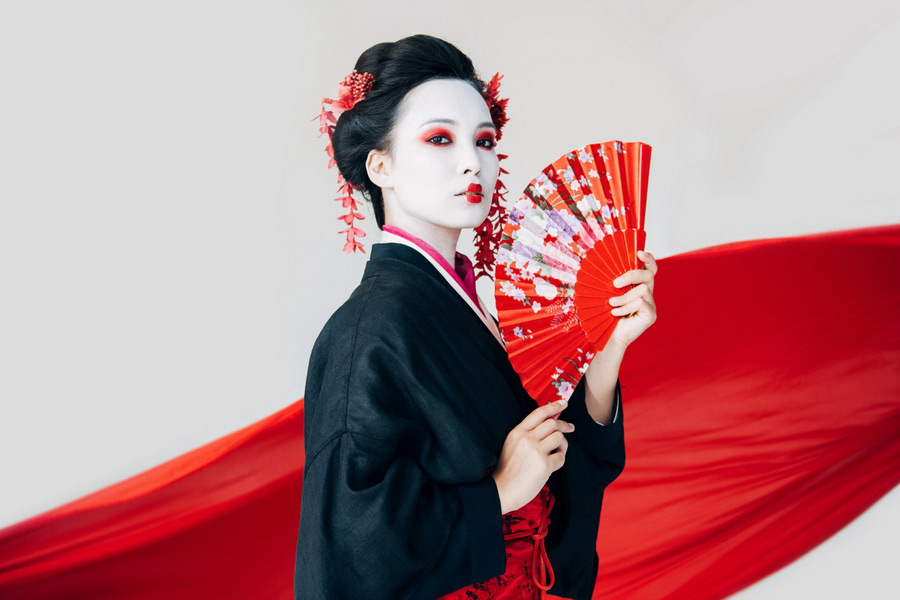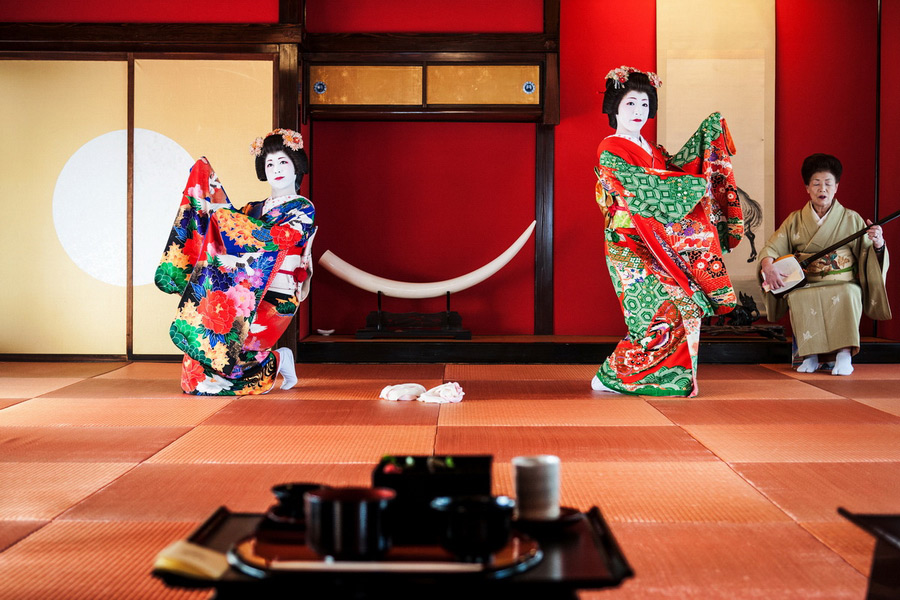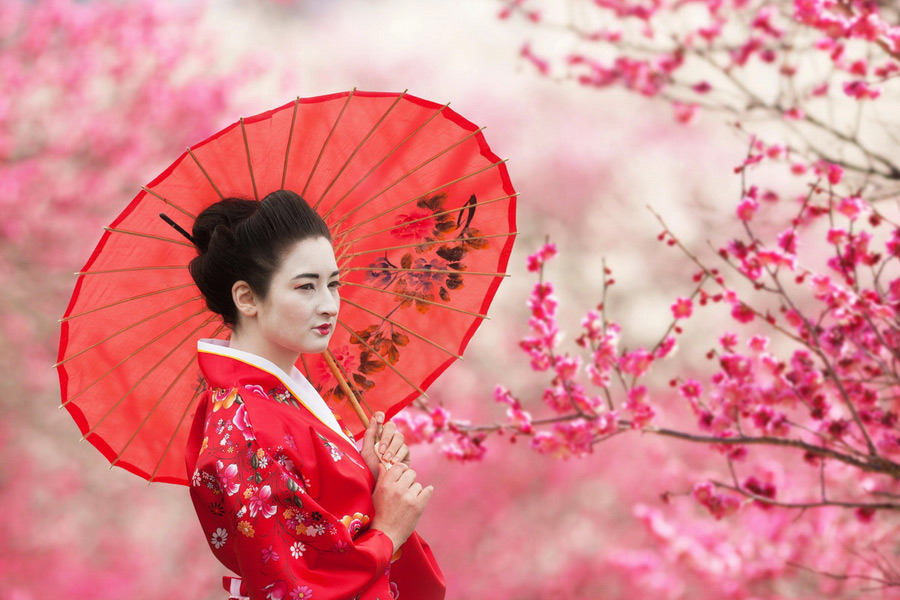
Geishas are incredible and mysterious women who continue to inspire the world with their beauty and elegance.
The history and traditions of this unique occupation make it a significant part of Japanese culture. Outside the Land of the Rising Sun, a geisha is an iconic image of the country, along with samurais, ninjas, and sumo wrestlers.
Who is a Geisha?
A geisha is a professional artisan who entertains guests during banquets, ceremonies, parties, and other events. The term 'geisha' consists of two words: 'gei' meaning 'art' and 'sha' meaning 'person.' In the Kyoto dialect, they are also known as 'geiko,' where 'ko' means 'child'.
Geikos must observe Japanese traditions and be skillful in singing, dancing, playing musical instruments, reciting hokku poetry, engaging in conversation, and creating games to make the evening enjoyable. Their goal is to amuse people. In addition, they should demonstrate proficiency in calligraphy, flower arrangement, and tea ceremonies.
What Do Geishas Do to Entertain?

At group dinner shows, while guests eat, geishas perform traditional dances specific to the region, accompanied by shamisen, and play games where the loser typically drinks another glass of beer. The first 40-50 minutes of the banquette are devoted to discussion of modern literature and art. The topics can be diverse, and the geisha must show her competence.
Geisha banquets, called ozashiki, can take place in tea houses (ochaya), Japanese-style hotels, and traditional Japanese restaurants, where these amazing ladies host the event. However, they are not responsible for organizing food, drinks, or hall decorations. Their only job is to entertain guests. Ozashiki lasts a few hours, during which geikos can drink sake or beer but not eat. Therefore, they have a good meal before the banquet.
The party usually lasts two hours and can cost up to $3,000. Geishas charge per hour. Additionally, a geisha can be hired for a stroll, to be a companion at the theater, or for dinner at a restaurant.
What Do Geishas Look Like?
They can be easily distinguished from other women in the crowd. However, many confuse them with a maiko – the geisha’s apprentice, who is a young girl between 15 and 20 years old. Here are some points to help you quickly recognize a real geisha and a maiko.
Geiko and Maiko Outfit and Footwear
Geishas and maikos wear kimonos. The kimono’s design, color, and patterns depend on the season.
- Unlike their disciples, maikos, the geisha's outfits are in one color and have a simple pattern at the bottom, symbolizing their maturity. The style can be called a formal kimono that married women wear at official events or ceremonies.
- The maiko’s kimono features a wide, heavy, and long sash (obi) (around 5 meters) that goes down to the back, showing the end. On the contrary, the geisha’s obi is shorter, like a square bow knot on the back.
- Besides, it’s easy to differentiate geisha from maiko by the undercollar. While the former’s undercollar will be completely white, the latter’s will be dominantly red and hanging loosely.
- As for footwear, geishas wear shorter wooden sandals, whereas maikos wear tall wooden clogs (okobo), except for special occasions.
Hairstyling

The geisha's standard hairstyle is called shimada mage, where the hair is tied back with katsura (wigs) on the sides. Their hairstyle is simple and does not involve accessories like pins and flowers.
In contrast, the maiko’s hairstyle is much more ornate. As they undergo training, it changes according to their years of experience. Maikos do not wear wigs but let their hair grow out to be tied. In this style, the hair is formed into a high bun with a red piece of cloth in the front and back, adorned with seasonal flowers (shidare-kanzashi) and sides waxed to resemble spreading wings. After 2 or 3 years, they will wear a piece of cloth only in the back, signifying their maturity.
Makeup

Seasoned geishas were never seen wearing full white face makeup regularly unless they were entertaining guests. Similarly, they did not routinely use bright makeup for eyes and lips.
White face makeup is more customary for maikos. It covers the face, neck, and chest. While the W or V-shaped patch of skin considered sensual (the nape) remains unpainted along with the hairline for maikos, geishas do not have these bare spots.
Visitors can easily tell the difference between a maiko and a geiko by looking at their lips. For example, novice maikos only wear lipstick on their lower lips. As they advance in the profession, they wear lipstick on both lips but in a smaller proportion. Established geishas, however, have their lips fully painted in red.
Both maikos and geishas apply blush to the areas around the eyes and nose. They highlight their eyebrows with red and black pigment and add black liner to their eyelids.
Any tourist in Japan can enjoy a maiko or geiko makeover for a certain amount of money. This includes full makeup, a hairdo, and wearing the full geisha garment. Male tourists can try a samurai or ninja outfit, followed by a photo shoot for lasting memories!
What Geishas Are Not?
Geishas are not prostitutes and have no connection to the sex industry. The misconception about their role is portrayed in the movie “Memoirs of a Geisha”, triggering a wave of resentment in Japan. The prototype for the main protagonist was a real woman, Mineko Iwasaki, a remarkable geiko of her time. She eventually sued the American writer Arthur Golden for defamation and authored her book, “Geisha of Gion”, published in 2012.
Nevertheless, the image of these Japanese women as high-end courtesans traces back to the post-war occupation of Japan, when a large number of American soldiers lived in the country. During those years, some Japanese girls in the sex industry dressed as geishas to attract US soldiers, even though they were never part of the geisha community. This resulted in a widespread misunderstanding in the West about the geisha's true profession, with many believing that they offered sex services, which is far from the truth.
If you wish to know more about geishas, here is a quick snapshot of their history.
The Geisha History
It may be surprising to learn that the first geishas were men, or otoko geishas, also dubbed taikomochi because they played a Japanese drum, the taiko, in the pleasure districts to entertain clients waiting for the oiran (courtesans) to accept them. Some even danced and recited poetry. Although considered low-class entertainers, they were quite popular in the early 17th century. Female geishas did not appear until two decades later, around 1750. These odoriko (dancers) and shamisen performers quickly replaced men by 1780.
Historically, a geisha assisted an oiran (oirans also entertained their clients with dances) as an artisan who could provide services in designated red-light districts in Edo (modern-day Tokyo), Kyoto, and other towns during the Edo period. Since the oiran feared geishas could steal their high-paying customers, the laws of that time did not allow geishas to provide personal services.
However, many wealthy clients turned their attention to less expensive but graceful and more educated geikos for entertainment and often invited them to their parties and dinner events. In the early Meiji Period (1868-1912), their popularity as hospitality entertainers peaked. In 1920, there were around 80,000 geishas. Sadly, their numbers have dwindled since World War II and the prevailing Westernization. Today, there are approximately 1,000 of them, mainly residing in Tokyo and Kyoto.
Facts About Modern Geishas

They Live in Special Districts
Modern geishas move to districts called hanamachi (flower town). Their houses are called okiya, where they undergo training supervised by an okaasan (mother) and onesan (old sister), who are usually retired geikos.
Training Takes Around 6 Years
Historically, geishas would start training at the age of six and train for years. Today, young girls must finish high school before entering the profession and becoming part of the okiya. The apprenticeship period lasts 5 to 6 years in Kyoto and only a year in Tokyo before they become established geishas.
They do not need to have money to be accepted. The okiya covers all expenses during the training period. Once a maiko becomes a geisha and starts working, she repays the debt.
Might Have a Rich Sponsor
A danna is a wealthy man and a generous patron who pays for a geisha's substantial expenses, such as her kimono. They might end up in a romantic relationship, but that's not a requirement. For Japanese men, being a patron is more about status than anything else. A geisha can have several patrons throughout her career. While it isn’t necessary, having a patron can help a geisha become more independent in her career.
Although geishas are not allowed to marry, those wishing to do so must leave the profession.
Don’t Want to Be Stopped At Streets
Real maikos are very busy studying dance, music, calligraphy, and other traditional arts. Young girls also do housework. They start dressing and putting on makeup only in the evening, which can take up to 2 hours. Then, at around 6:00 PM, they head to a tea house or ozashiki to perform. While walking, they do not want to be disturbed.
There Are Fake Maikos
When heading to an ochaya or a banquet, maikos or geishas will never carry a cell phone or any modern technology. It is strictly prohibited. If you see a maiko with a mobile phone, it is a fake one from the Maiko-Henshin Studio Shiki. The same is true for women in kimonos and powdered faces who willingly shake hands with tourists and pose for photos. Additionally, Henshin Studios maikos are prohibited by law from resembling authentic geishas in their appearance. Consequently, their hairstyle, kimono, or makeup will have deliberate inaccuracies.
“Please Don’t Touch a Maiko”
This is a reality. Some tourists even chase maikos on their way to tatami rooms to take photos or touch them, causing too much trouble. Officials had to put up warning signs to ward off intrusive foreigners.
Furthermore, photos of geishas are not allowed unless you have a permit. Breaking this rule will result in a fine of 10,000 yen ($64/EUR 59).
Get Pocket Money
Maikos do not receive a salary or fixed income but get monthly pocket money they can use as they wish during their day off.
Foreigners Can Become Geishas
The cultural tradition of geishas has occasionally seen foreigners becoming part of this exclusive occupation. There is no strict ban on training foreign women as geikos in Japan. In the 1970s, Lisa Dalby, an American anthropologist, worked as a geisha (although without official registration) for a year and used this experience for her dissertation. Additionally, citizens from countries like China, Romania, Peru, and Australia have been among the geishas in Japan.
It Isn’t Easy to Get an Invitation to the Ochaya
Unlike a regular restaurant, an ochaya or teahouse is an exclusive place, and new clients need a recommendation from a local to attend a geiko dinner there.
Hanamachi Districts to Add to Your Bucket List

In Tokyo, tourists can explore Akasaka, Asakusa, Kagurazaka, and Shinbashi. Each district has its own unique vibe and offers different experiences.
In Kyoto, the hanamachi districts of Gion, Pontocho, Kamishichiken, and Miyagawa-cho are ideal places to wander around in the evening to spot a geiko.
Taking a walking tour in Osaka's Shinmachi district also offers a chance to see a maiko or geisha on their way to work.
How Else Can You Experience Geisha Culture?
Attend One of the Annual Geiko Festival Shows
Several traditional dance performances take place in Kyoto in the spring. Each district has its own show – Miyako Odori, Kitano Odori, Kyo Odori, and Kamogawa Odori.
Every year, starting on April 1st and lasting the entire month, the Gion district hosts the Miyako Odori, a grand festival showcasing maiko and geisha dances during the peak cherry blossom season. Spectators from different countries come together to witness this event held at the Gion Kobu Kaburenjo Theater. There are four shows a day, each lasting an hour.
Ticket prices start at 4,000 yen and go up to 7,000 yen, with premium seats including a tea ceremony.
Visit Gion Corner
An excellent opportunity to experience traditional Kyoto and Japan is Gion Corner. Apart from a one-hour sampler of Japanese classical arts like puppetry, flower arranging, comedy, and music, it offers a glimpse into the geiko tradition.
Visit Kanazawa’s Higashi Chaya District
This beautiful traditional quarter in the capital of Ishikawa Prefecture is home to the Shima Ochaya, a former tea house now open to the public as a museum. You can peek inside the tatami rooms, see the musical instruments, and view the traditional utensils used for the tea ceremony.
Additionally, you can enjoy a leisurely walk through the streets of Higashi Chaya, lined with old buildings, shops, and restaurants.
Book a Private Tea or Dinner with a Geiko or Maiko
Having a private dinner with a geisha or maiko can be the highlight of your trip. However, be prepared to spend between $700 and $1000. You will be at the center of the show, enjoying a geisha playing the shamisen, another geiko or maiko performing a traditional dance, and another skillfully and gracefully serving tea.

